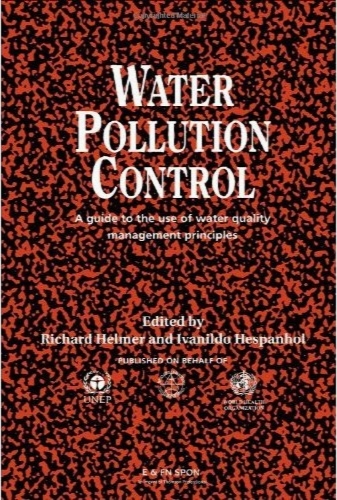Water pollution control : a guide to the use of water quality management principles
- نوع فایل : کتاب
- زبان : انگلیسی
- مؤلف : Richard Helmer; Ivanildo Hespanhol; United Nations Environment Programme.; Water Supply and Sanitation Collaborative Council.; World Health Organizati
- چاپ و سال / کشور: 1997
- شابک / ISBN : 9780203477540
Description
Chapter 1 - Policy and Principles 1.1 Introduction 1.2 Policy framework 1.3 Guiding principles for water pollution control 1.4 Strategy formulation 1.5 References Chapter 2 - Water Quality Requirements 2.1 Introduction 2.2 Why water quality criteria and objectives? 2.3 Water quality criteria for individual use categories 2.4 Water quality objectives 2.5 Conclusions and recommendations 2.6 References Chapter 3 - Technology Selection 3.1 Integrating waste and water management 3.2 Wastewater origin, composition and significance 3.3 Wastewater management 3.4 Pollution prevention and minimisation 3.5 Sewage conveyance 3.6 Costs, operation and maintenance 3.7 Selection of technology 3.8 Conclusions and recommendations 3.9 References Chapter 4 - Wastewater as a Resource 4.1 Introduction 4.2 Types of reuse 4.3 Implementing or upgrading agricultural reuse systems 4.4 Technical aspects of health protection 4.5 Conclusions and recommendations 4.6 References Chapter 5 - Legal and Regulatory Instruments 5.1 Introduction 5.2 Inventories for pollution control 5.3 Derivation of standards for point sources 5.4 Regulation of point sources 5.5 Non-point source pollution 5.6 Groundwater protection 5.7 Transboundary pollution 5.8 Conclusions 5.9 References Chapter 6 - Economic Instruments 6.1 Introduction 6.2 Why use economic instruments? 6.3 Applying economic instruments 6.4 Choosing between instruments 6.5 Application in developing countries 6.6 Conclusions 6.7 References Chapter 7 - Financing Wastewater Management 7.1 Introduction 7.2 The challenges of urban sanitation 7.3 The financial challenges 7.4 Strategic planning and policies for sustainable sanitation services 7.5 Conclusions 7.6 References Chapter 8 - Institutional Arrangements 8.1 Introduction 8.2 The water pollution control sub-sector 8.3 Institutions and organisations 8.4 Criteria and determinants 8.5 Examples of institutional arrangements 8.6 Capacity building 8.7 Conclusions 8.8 References Chapter 9 - Information Systems 9.1 Introduction 9.2 The importance of integration 9.3 Specifying information needs 9.4 Information gathering and dissemination 9.5 From data to information tools 9.6 Design of monitoring networks and selection of variables 9.7 Monitoring technology 9.8 References Chapter 10 - Framework for Water Pollution Control 10.1 Introduction 10.2 Initial analysis of water quality problems 10.3 Establishing objectives for water pollution control 10.4 Management tools and instruments 10.5 Action plan for water pollution control 10.6 References Case Study I - The Ganga, India I.1 Introduction I.2 The Ganga river I.3 The Ganga Action Plan I.4 Implementation problems I.5 River water quality monitoring I.6 The future I.7 Conclusions and lessons learned I.8 Recommendations I.9 Source literature Case Study II - Shanghai Huangpu River, China II.1 Introduction II.2 Background information II.3 Institutional development and industrial pollution control II.4 Pollution control strategy for the Huangpu River II.5 Other major measures used in cleaning the Huangpu River II.6 Conclusions II.7 References Case Study III - The Pasig River, Philippines III.1 Country profile III.2 Basin identification III.3 Pre-intervention situation III.4 The intervention scenario III.5 Lessons learned, constraints and opportunities III.6 Conclusions and recommendations Case Study IV - Nigeria IV.1 Introduction IV.2 National environmental policy IV.3 Water resources management IV.4 Industrial water pollution control programme IV.5 Conclusions IV.6 References Case Study V - The Witbank Dam Catchment V.1 Introduction V.2 Background information V.3 The Witbank Dam catchment V.4 Pre-intervention situation V.5 Intervention with a new approach V.6 Shortcomings of the approach V.7 Conclusions V.8 References Case Study VI - The Upper Tietê Basin, Brazil VI.1 Introduction VI.2 The metropolitan region of São Paulo VI.3 Pre-intervention situation VI.4 The Tietê Project VI.5 Industrial wastewater management VI.6 Conclusions VI.7 References Case Study VII - The Mezquital Valley, Mexico VII.1 Introduction VII.2 The Mezquital Valley VII.3 Pre-intervention situation VII.4 Intervention scenario VII.5 Lessons learned, constraints and opportunities VII.6 Conclusions and recommendations VII.7 References Case Study VIII - Lerma-Chapala Basin, Mexico VIII.1 Introduction VIII.2 The Lerma-Chapala basin VIII.3 Pre-intervention situation VIII.4 Intervention scenario VIII.5 Conclusions and lessons for the future VIII.6 Final reflections Case Study IX - The Danube Basin IX.1 Introduction IX.2 Economic activities in the basin IX.3 The Environmental Programme for the Danube river basin IX.4 The strategic action plan IX.5 Problems and priorities IX.6 Strategic directions IX.7 Conclusions IX.8 References Case Study X - Moscow Region, Russia X.1 Introduction X.2 Description of the region X.3 Water systems X.4 Water resources assessment X.5 Pollution sources X.6 Major problems X.7 The programme X.8 International co-operation X.9 Conclusion X.10 References Case Study XI - Cyprus XI.1 Introduction XI.2 Water resources XI.3 Measures to conserve and replenish groundwater XI.4 Direct use of treated wastewater for irrigation XI.5 Pollution of water resources XI.6 Conclusions and recommendations XI.7 References Case Study XII - Kingdom of Jordan XII.1 Introduction XII.2 General information on Jordan and Greater Amman XII.3 Wastewaters and water pollution control XII.4 Existing major wastewater management problems and needs XII.5 Management solution alternatives XII.6 Recommendations and possible results XII.7 References Case Study XIII - Sana'a, Yemen XIII.1 Introduction XIII.2 Water issues XIII.3 Planned interventions XIII.4 Lessons learned and conclusions XIII.5 References Appendix - Participants in the Working Group Water Pollution Control
This is a handbook for policy makers and environmental managers in water authorities and engineering companies engaged in water quality programs, especially in developing countries. It is also suitable for use as a textbook or as training material for water quality management courses. It is a companion volume to Water Quality Assessment and Water Quality Monitoring.


